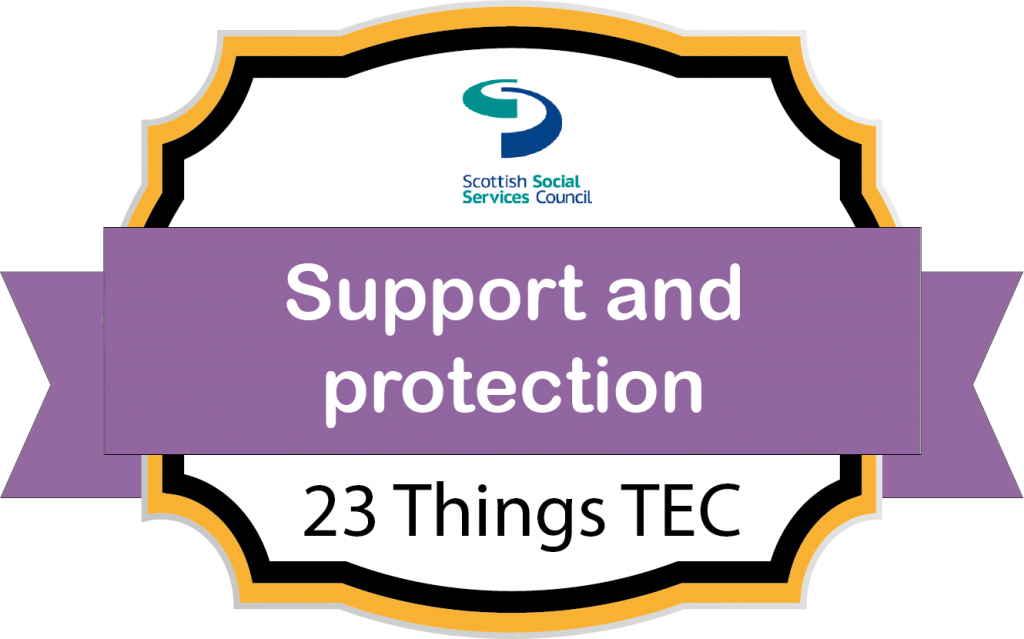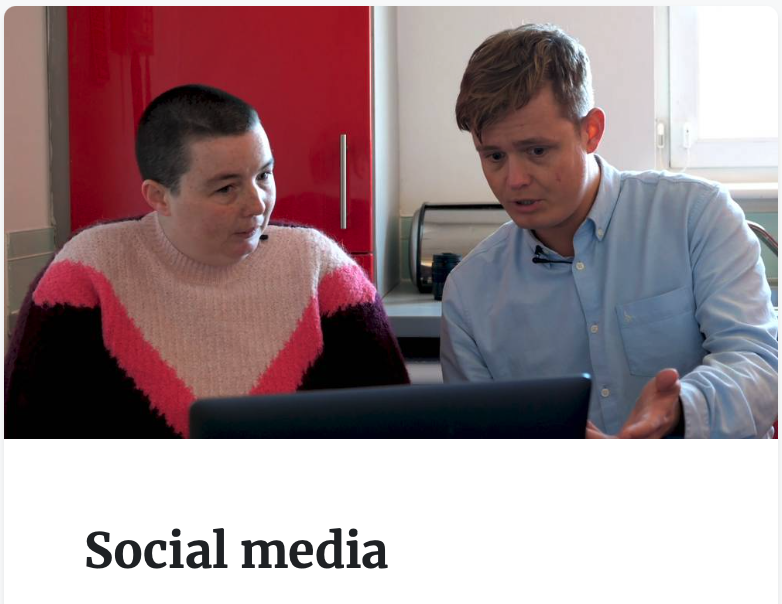In Thing 18, we covered how you can recognise malicious activities such as scams, phishing etc. so we are now going to cover what you should do if you suspect someone may be vulnerable or has possibly experienced malicious activity.
Open badge information
SSSC 23 Things TEC: Thing 20 Protecting people badge

Counts towards the Support and Protection badge.

Introduction
As social service workers, we all have a duty to promote the wellbeing of people we are supporting, and to try to minimise any harm to them. This includes online activities, so if you suspect that someone is at risk of harm or has been harmed, you must follow your organisation’s policies and procedures for protecting people. Unless it is part of your role, you must not try to investigate or try to resolve this yourself but should report your concerns immediately, following your procedures.
Learning activity 1
This scenario from our Making Better Decisions resource shows what can happen if you try to resolve an issue yourself. Please work through the scenario and follow the instructions about writing a reflective account. You will need to attach your reflective account to your application if you want to apply for the open badges to this. You can also use the reflective account to apply the open badge linked to the scenario

(Tip: If you try all the different options in the scenario, you can see what happens if you chose the wrong option. This can help you to see why it is so important to take the right actions.)
Things to consider if you think someone has been harmed
Like other forms of harm and abuse, you might notice some signs and symptoms that indicate something has happened. You can find out more about signs and symptoms of potential harm and abuse in the Adult Support and Protection smartphone app. You can download versions for Apple and Android smartphones by clicking on these links.
Online scammers and abusers can be very skilled at using emotions to get people to do what they want, so you need to be aware that the person could feel very anxious or embarrassed and may not want to acknowledge what has happened. Scammers often threaten their victims to try to stop them from speaking out, so you may need to reassure them about reporting what has happened. Remember, if you think the person is at risk of harm or abuse, you still need to report your concerns even if the person asks you not to do this.
Where the abuse involves money, it is important that the Police are informed as soon as possible. They have specially trained teams that to investigate cyber crime, so the information might help them to tackle this. As it is a requirement of the SSSC Code of Practice for Social Service Workers that you must report any illegal activities, you must make sure you know what your organisation’s policies are for reporting criminal activity to the Police, and follow these as soon as you suspect something illegal may have happened.
Social media platforms are often designed to encourage people to keep looking at them, so you need to be aware that even when they may be used as a way of abusing people, the victims of the abuse may find it very difficult to stop looking at their social media feeds. It might seem obvious and tempting to suggest that the person simply stops looking at their social media, however this may not be easy for them, especially if they use the social media to maintain positive relationships. They may need guidance and support to help them with this.
Learning activity 2
Please read the following short case study. If you were a worker supporting Jacqui, identify the important points you need to consider and write these down. Then tell us what you would do in a short reflective account, linking this to your organisation’s policies and procedures. If you want to apply for the open badge linked to this Thing, you will need to upload your reflective account as part of your evidence.

Jacqui lives alone and has mental health issues that mean she needs support with many aspects of her daily living. She spends a lot of time each day on her smartphone, mostly using social media to keep in touch with ‘friends’ many of whom she only knows through social media.
When you go to support her today, she appears a bit upset. Unknown to you, one of her online friends in the United States, Jim, has messaged her to say that he is ill and needs to get some medication. He told Jacqui he had no money as he had to spend it all to get food for his young daughter, so asked if she could lend him some which he could use to buy the medication to relieve his pain. Jim tells Jacqui he is in a lot of pain.
As someone who has a lot of compassion, Jacqui hates the thought of someone being in pain and is touched that Jim is thinking about his daughter before himself, so she decided to send him as much money as she can afford. She tells Jim that she will send him some money and he responds by sending her instructions about how to do this. He also pleads with Jacqui not to tell anyone because as he is such a proud man, he may harm himself if anyone found out he had to ask her for money.
When you arrive, Jacqui has been worrying about Jim. Initially she won’t tell you why she is upset in case it leads to Jim harming himself. However, she eventually tells you what has been happening and that she transferred some money from her benefits to pay for his medication. What should you do now?
Once you have finished Learning Activity 2, you may find it helpful to look at this scenario about Social Media from our cyber security learning resources. It will show you the risks associated with sharing too much information on social media platforms.

Open Badge
Now you have completed this topic, you can apply for the open badge ’Supporting vulnerable people’. {hyperlink to be added} Please look at the criteria for this badge and upload your evidence to meet these, including what you have written for the two learning activities.